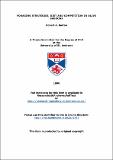Files in this item
Foraging strategies, diet and competition in olive baboons
Item metadata
| dc.contributor.advisor | Whiten, Andrew | |
| dc.contributor.author | Barton, Robert A. | |
| dc.coverage.spatial | 374 | en_US |
| dc.date.accessioned | 2012-06-13T14:18:14Z | |
| dc.date.available | 2012-06-13T14:18:14Z | |
| dc.date.issued | 1990 | |
| dc.identifier | uk.bl.ethos.238375 | |
| dc.identifier.uri | https://hdl.handle.net/10023/2767 | |
| dc.description.abstract | Savannah baboons are amongst the most intensively studied taxa of primates, but our understanding of their foraging strategies and diet selection, and the relationship of these to social processes is still rudimentary. These issues were addressed in a 12-month field study of olive baboons (Papio anubis) on the Laikipia plateau in Kenya. Seasonal fluctuations in food availability were closely related to rainfall patterns, with the end of the dry season representing a significant energy bottleneck. The distribution of water and of sleeping sites were the predominant influences on home range use, but certain vegetation zones were occupied preferentially in seasons when food availability within them was high. The influence of rainfall on monthly variation in dietary composition generally mirrored inter-population variation. Phytochemical analysis revealed that simplistic dietary taxonomies can be misleading in the evaluation of diet quality. Food preferences were correlated with nutrient and secondary compound content. The differences between males and females in daily nutrient intakes were smaller than expected on the basis of the great difference in body size; this was partly attributable to the energetic costs of reproduction, and possibly also to greater energetic costs of thermoregulation and lower digestive efficiency in females. A strongly linear dominance hierarchy was found amongst the adult females. Dominance rank was positively correlated with food ingestion rates and daily intakes, but not with time spent feeding or with dietary quality or diversity. In a provisioned group, high-ranking females occupied central positions, while low-ranking females were more peripheral and were supplanted more frequently. In the naturally-foraging group, the intensity of competition was related to the pattern of food distribution, but not to food quality, and was greater in the dry season than in the wet season. The number of neighbours and rates of supplanting were correlated with rank, and evidence was presented that high-rankers monopolised arboreal feeding sites. | en_US |
| dc.language.iso | en | en_US |
| dc.publisher | University of St Andrews | |
| dc.subject.lcc | QL737.P93B2 | |
| dc.subject.lcsh | Baboons--Behavior | en_US |
| dc.subject.lcsh | Cercopithecidae | en_US |
| dc.title | Foraging strategies, diet and competition in olive baboons | en_US |
| dc.type | Thesis | en_US |
| dc.type.qualificationlevel | Doctoral | en_US |
| dc.type.qualificationname | PhD Doctor of Philosophy | en_US |
| dc.publisher.institution | The University of St Andrews | en_US |
This item appears in the following Collection(s)
Items in the St Andrews Research Repository are protected by copyright, with all rights reserved, unless otherwise indicated.

